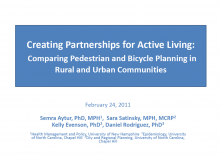We are pleased to announce an exciting new alliance between Active Living Research and GP RED to co-host and coordinate...
Creating Partnerships for Active Living: Comparing Pedestrian and Bicycle Planning in Rural and Urban Communities

Presentation at the 2011 Active Living Research Annual Conference
Background:
Pedestrian and bicycle planning processes can help to create partnerships, programs, policies, and facilities to encourage active living. However, such planning has traditionally been viewed from an urban design perspective, rather than a regional planning perspective that considers the needs of both rural and urban communities.
Objectives:
This transdisciplinary study aims to: 1) explore the prevalence of local pedestrian/bicycle plans in North Carolina (NC) according to geography, regional planning, and sociodemographics; 2) examine variations in plan quality between rural and urban areas, especially with respect to public participation, stakeholder involvement , and implementation elements; 3) assess correlations between plan prevalence and population levels of walking/bicycling to work.
Methods:
Pedestrian and bicycle plans were identified through web searches, a listserv request to NC planners, a library at the NC Department of Transportation, and follow-up telephone contacts. Additional regional planning information was collected from Metropolitan Planning Organizations (MPOs) and Rural Planning Organizations (RPOs). U.S. Census data was collected for each NC municipality (n=543) and merged with qualitative information collected through a content analysis of municipal pedestrian/bicycle plans. Census indicators included median annual household income, median population age, median high school graduation rate, percentage of rural farm land, percentage of land in urban areas, population size, rate of population growth, racial composition, and the percentage of population walking or bicycling to work. Rurality was defined in two ways: 1) areas excluded from Census-defined urbanized areas or urban clusters; 2) areas including rural farm land. All (n=38) pedestrian and combine pedestrian/bicycle plans were scored, using the content analysis, with respect to plan quality (e.g., public participation, fact base, policies and proposals, implementation, and evaluation strategies). Chi-square tests and Fisher’s Exact tests were used to assess categorical differences in plan prevalence according to geographic and sociodemographic characteristics. Correlations between these characteristics and plan quality were assessed using nonparametric tests for ordinal data.
Results:
Sixty-three pedestrian, bicycle, or combined pedestrian/bicycle plans were identified in NC at the municipal level, in 57 distinct municipalities; 12 of them in rural areas. Additionally, 12 plans were developed at the regional level, and 4 at the county level. Sixty-two percent of the rural plans were developed in lower-income or lower-education communities.
Despite significantly lower plan prevalence overall, rural areas tended to develop higher quality plans compared to those of urban areas. Specifically, rural areas achieved higher plan quality scores with respect to public participation and implementation elements (p<0.05). Rural areas were more likely to engage diverse partners (e.g., business groups, nonprofits, and the public) in the planning process (p<0.05); however, public health professionals, state transportation planners, and law enforcement officials were less involved in rural planning processes than in urban ones. Compared to urban areas, rural plans were more likely to identify persons/organizations that were accountable for implementation (p<0.05).
With respect to regional planning, 47 municipalities were members of the two MPOs that had developed pedestrian and/or bicycle plans; only 5 municipalities were members of the single RPO that had developed a plan. Although urban communities with local plans were also more likely to have regional (MPO-level) pedestrian/bicycle plans (p <0.0001), this relationship was not significant for rural farm land areas located within MPOs, or for RPO members. Correlations between plan prevalence and higher percentages of active commuting were strongest in lower-income rural areas, compared to other areas (p<0.05).
Conclusions:
Pedestrian and bicycle planning may benefit communities directly, by affecting physical activity outcomes, and indirectly, through partnerships that may build community capacity to improve population health. Rural areas, in particular, face unique challenges in coordinating local and regional planning to support walking and bicycling. Public health professionals and transportation planners, by becoming more involved in the planning process at both local and regional levels, can partner with residents and other stakeholders to support active living.
Support:
This work was supported through the North Carolina Physical Activity Policy Research Center (http://www.hpdp.unc.edu/projects/ncpaprc), funded by the Centers for Disease Control and Prevention (CDC) cooperative agreement #U48-DP000059 and an educational grant from the Southern Transportation Center. The UNC Center for Health Promotion and Disease Prevention is a member of the Prevention Research Centers’ Program of CDC. The content is solely the responsibility of the authors and does not necessarily represent the official views of the CDC.
STAY UP TO DATE
RECENTLY ADDED TOOLS & RESOURCES
MOVE! A BLOG ABOUT ACTIVE LIVING
The "Active Living Conference" aims to break down research and practice silos and...







